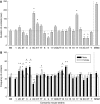Genetic mapping of social interaction behavior in B6/MSM consomic mouse strains
- PMID: 19936911
- PMCID: PMC2853700
- DOI: 10.1007/s10519-009-9312-x
Genetic mapping of social interaction behavior in B6/MSM consomic mouse strains
Abstract
Genetic studies are indispensable for understanding the mechanisms by which individuals develop differences in social behavior. We report genetic mapping of social interaction behavior using inter-subspecific consomic strains established from MSM/Ms (MSM) and C57BL/6J (B6) mice. Two animals of the same strain and sex, aged 10 weeks, were introduced into a novel open-field for 10 min. Social contact was detected by an automated system when the distance between the centers of the two animals became less than approximately 12 cm. In addition, detailed behavioral observations were made of the males. The wild-derived mouse strain MSM showed significantly longer social contact as compared to B6. Analysis of the consomic panel identified two chromosomes (Chr 6 and Chr 17) with quantitative trait loci (QTL) responsible for lengthened social contact in MSM mice and two chromosomes (Chr 9 and Chr X) with QTL that inhibited social contact. Detailed behavioral analysis of males identified four additional chromosomes associated with social interaction behavior. B6 mice that contained Chr 13 from MSM showed more genital grooming and following than the parental B6 strain, whereas the presence of Chr 8 and Chr 12 from MSM resulted in a reduction of those behaviors. Longer social sniffing was observed in Chr 4 consomic strain than in B6 mice. Although the frequency was low, aggressive behavior was observed in a few pairs from consomic strains for Chrs 4, 13, 15 and 17, as well as from MSM. The social interaction test has been used as a model to measure anxiety, but genetic correlation analysis suggested that social interaction involves different aspects of anxiety than are measured by open-field test.
Figures




Similar articles
-
QTL analysis of measures of mouse home-cage activity using B6/MSM consomic strains.Mamm Genome. 2010 Oct;21(9-10):477-85. doi: 10.1007/s00335-010-9289-z. Epub 2010 Oct 1. Mamm Genome. 2010. PMID: 20886216 Free PMC article.
-
Multigenic factors associated with a hydrocephalus-like phenotype found in inter-subspecific consomic mouse strains.Mamm Genome. 2008 May;19(5):333-8. doi: 10.1007/s00335-008-9112-2. Epub 2008 May 29. Mamm Genome. 2008. PMID: 18509705
-
Mapping of Genetic Factors That Elicit Intermale Aggressive Behavior on Mouse Chromosome 15: Intruder Effects and the Complex Genetic Basis.PLoS One. 2015 Sep 21;10(9):e0137764. doi: 10.1371/journal.pone.0137764. eCollection 2015. PLoS One. 2015. PMID: 26389588 Free PMC article.
-
Segregation of a QTL cluster for home-cage activity using a new mapping method based on regression analysis of congenic mouse strains.Heredity (Edinb). 2014 Nov;113(5):416-23. doi: 10.1038/hdy.2014.42. Epub 2014 Apr 30. Heredity (Edinb). 2014. PMID: 24781804 Free PMC article.
-
Complex quantitative traits cracked by the mouse inter-subspecific consomic strains.Exp Anim. 2012;61(4):375-88. doi: 10.1538/expanim.61.375. Exp Anim. 2012. PMID: 22850637 Review.
Cited by
-
Sweetened ethanol drinking during social isolation: enhanced intake, resistance to genetic heterogeneity and the emergence of a distinctive drinking pattern in adolescent mice.Genes Brain Behav. 2017 Mar;16(3):369-383. doi: 10.1111/gbb.12346. Epub 2016 Nov 14. Genes Brain Behav. 2017. PMID: 27706910 Free PMC article.
-
QTL analysis of measures of mouse home-cage activity using B6/MSM consomic strains.Mamm Genome. 2010 Oct;21(9-10):477-85. doi: 10.1007/s00335-010-9289-z. Epub 2010 Oct 1. Mamm Genome. 2010. PMID: 20886216 Free PMC article.
-
Genetic mapping of escalated aggression in wild-derived mouse strain MSM/Ms: association with serotonin-related genes.Front Neurosci. 2014 Jun 11;8:156. doi: 10.3389/fnins.2014.00156. eCollection 2014. Front Neurosci. 2014. PMID: 24966813 Free PMC article.
-
Host genetics maps to behaviour and brain structure in developmental mice.Behav Brain Funct. 2025 Jan 2;21(1):1. doi: 10.1186/s12993-024-00261-y. Behav Brain Funct. 2025. PMID: 39748372 Free PMC article.
-
Possibility of Autonomous Estimation of Shiba Goat's Estrus and Non-Estrus Behavior by Machine Learning Methods.Animals (Basel). 2020 Apr 29;10(5):771. doi: 10.3390/ani10050771. Animals (Basel). 2020. PMID: 32365596 Free PMC article.
References
Publication types
MeSH terms
LinkOut - more resources
Full Text Sources
Molecular Biology Databases

